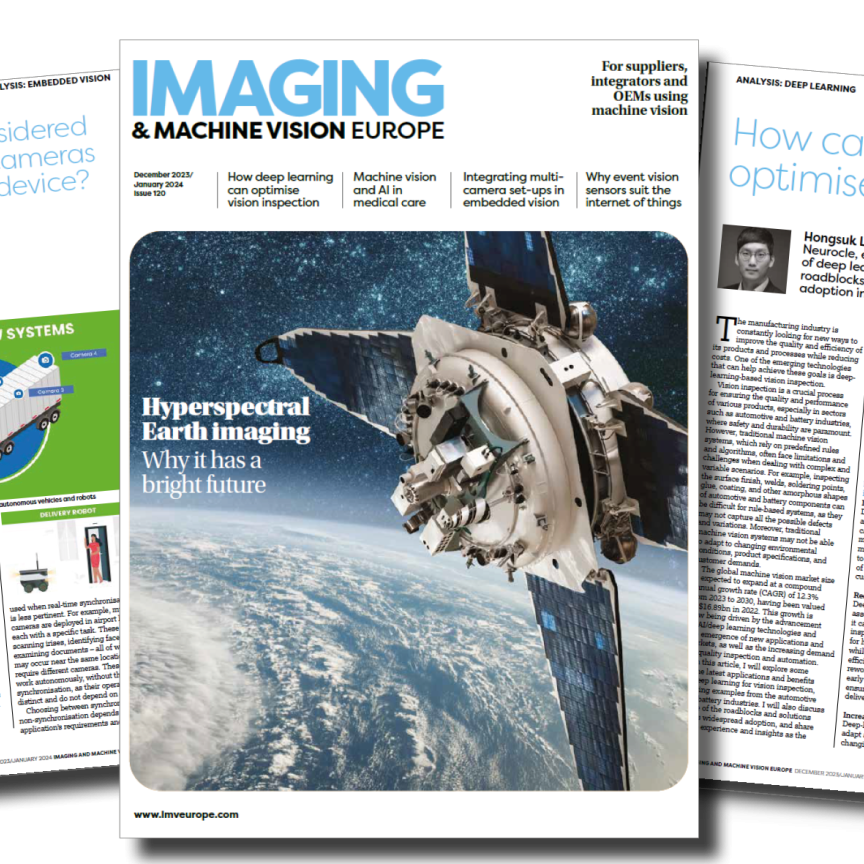Sony has announced three new industrial camera modules which have been added to its 2020 line-up, all of which are available to ship immediately.
The XCG-CG40 (b/w) delivers a resolution of 720x520 pixels, and outputs images at 300 frames per second (fps), transmitting over the GigE Vision 1.2 / 2.0 digital interface.
The XCL-CG160 (b/w) and XCL-CG160C (colour) both deliver a resolution of 1440x1080 pixels, with a frame rate of up to 127 fps, transmitting via the Camera Link 2.0 digital interface.
The three new modules use the Sony Pregius 1/2.9-type global-shutter CMOS sensor, which allows images to be captured in low light levels (b/w 0.5 lx, colour 12 lx), and a C-mount lens.
They are ideally suited to a wide range of industrial and ITS applications including fruit, bottle or medicine inspection (XCL-CG160/C) or position and alignment functions in small/compact robots (XCG-CG40).
Features and specifications
The new CameraLink modules’ measure 29 x 29 x 30 mm and weigh 53g. The GigE module measures 29 x 29 x 42 and weighs 65g.
They feature a signal to noise ratio of >50 dB, a dynamic region of interest, and an automatic- / manually-controllable shutter speed range of 60s to 1/100,000s. Additional features include area gain and defect correction with the XCL-CG160/C modules also adding shading correction.
All three modules can be fired via hardware and software triggers, with modes including free run, edge detection, width detection and burst trigger; the XCG-CG40 is also able to act as both the synchronisation master and slave device in a network using the IEEE1588 precision timing protocol, eliminating the need for dedicated timing devices and backups.
The modules enable power over CameraLink (PoCL) / power over Ethernet (PoE / IEEE802.3af) or via a DC +12 V input.
The cameras are able to operate at temperatures of -6 to +45oC, with a performance guaranteed temperature range of 0 to +40oC (32 to 104oF), and humidity levels between 20 and 80%.
All three are able to withstand vibrations to 10 G (20 Hz to 200 Hz) as well as shocks of up to 70 G.
The XCL-CG160/XCL-CG160C have a MTBF of 76,315 hours, with the XCG-CG40 having a MTBF of 58,525 hours.
Nvidia Jetson SDK for XCG-CP510 polarised camera
Sony Europe’s Image Sensing Solutions division has also announced an SDK for its XCG-CP510 polarised machine vision module that lets applications be developed for it via the Nvidia Jetson embedded AI computer platforms.
This is Sony’s (and the industry’s) second SDK for polarised cameras, with the first (for Windows) cutting development time for systems integrators by more than 75 per cent.
The XCG-CP510 uses the IMX250MZR sensor, the industry’s first to integrate polarisation functionality at the pixel level, to extract image data in 4 light planes – 0o, 90o, 45o, and 135o – with pixels assigned a plane in a 2x2 calculation unit and Stokkes Vector used to calculate the exact angle of light.
“The development and release of the SDK followed requests from customers who were looking to develop small, lightweight applications that could be deployed in, for example, drones”, said Sony ISS’s Arnaud Destruels.
“As we did with our original polarised SDK, we’ve continued to work closely with industry to identify the key functions and created highly-optimised image-processing algorithms that can be run on the Nvidia Jetson computers. So, depending on the application and the team, our SDKs reducing development from around 6, or even 24 months, down to 6 to 12 weeks.”
Key features
Support functions include demosaic and raw extraction.
The SDK’s ‘Cosine fit’ allows the developer to define a virtual polarizer angle for the whole image and the ‘Average’ function creates a non-polarised image from the raw data to simultaneously export what a standard machine vision camera would see for comparison.
Pre-processing functions calculate various polarization specific information like the ‘Degree of Polarisation’, ‘Stokkes Vector’ and the ‘Surface Normal Vector’.
At the higher-end level, ‘Applications-Oriented’ functions have been implemented to manage reflections and measure stress.
These functions’ algorithms have been optimised for accuracy and high computing to enable its use in real-time inspection.

